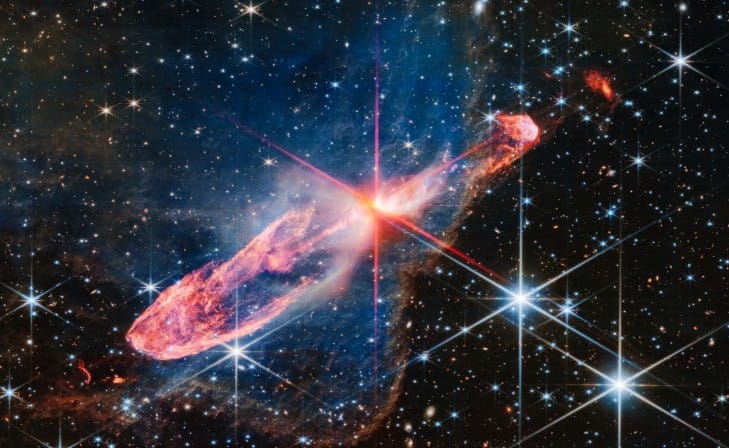NASA has made a groundbreaking discovery that’s shaking up the field of astrophysics. In the vast expanse of space, the space agency has found an object that defies classification and could potentially unlock secrets about the universe that we’ve never imagined. This celestial body is emitting both X-rays and radio waves—a combination never before observed in any star or galaxy. Not only is this discovery unlike anything we’ve seen, but it also raises more questions than answers. Scientists are now scrambling to determine the true nature of this mysterious object.

In this article, we’ll break down NASA’s discovery of ASKAP J1832-0911, what makes it so unique, and why it could change everything we know about space. We’ll also discuss what this means for our future understanding of the cosmos.
NASA Just Found Something in Space
| Discovery | Details |
|---|---|
| Object Name | ASKAP J1832-0911 |
| Location | Approximately 15,000 light-years away in the Milky Way galaxy |
| Key Feature | Emits X-rays and radio waves in a rhythmic pattern, unlike any known object |
| Possible Classifications | Could be a neutron star, white dwarf, or a completely new category of celestial body |
| Technology Used | Observed using NASA’s Chandra X-ray Observatory, ASKAP, and MeerKAT radio telescope |
| Published in | Published in Nature on May 28, 2025 |
NASA’s discovery of ASKAP J1832-0911 is one of the most intriguing and important astronomical events in recent years. The rhythmic emission of both X-rays and radio waves is unlike anything we’ve seen before and forces scientists to rethink their theories about the universe. Whether this object turns out to be a neutron star, a white dwarf, or something entirely new, it holds the potential to rewrite astrophysical textbooks and unlock new knowledge about the cosmos.
This discovery exemplifies the power of scientific collaboration, technological advancement, and the constant drive to explore the unknown. As we continue to study this enigmatic object, we’re reminded that there is always more to discover about the universe we live in.

What Makes This Discovery Unique?
NASA’s discovery of ASKAP J1832-0911 is extraordinary for several reasons. First, this object is emitting X-rays and radio waves in a highly rhythmic, almost predictable pattern—something that has never been seen before in space. The object bursts out both types of radiation for two minutes every 44 minutes, making it a mystery to scientists.
The Emission Pattern
What’s particularly unusual about ASKAP J1832-0911 is the dual nature of its emissions. X-rays are typically associated with extremely hot, dense objects like black holes or neutron stars, while radio waves are usually emitted by cooler objects like pulsars or quasars. But ASKAP J1832-0911 is showing us a unique combination of both, and that’s what makes it so intriguing.
Why Is This Important?
This discovery forces scientists to rethink the way they classify cosmic objects and the physics behind their emissions. Could this be a completely new type of object we’ve never encountered before? Or is it an exotic type of known object behaving in an unusual way? The possibilities are vast, and scientists are eager to delve deeper.
Possible Classifications
As exciting as it is, the discovery of ASKAP J1832-0911 has raised more questions than answers. What exactly is this mysterious object? There are a few possibilities:
1. Neutron Star
A neutron star is a dense, highly magnetized remnant of a massive star that has exploded in a supernova. These stars are known to emit both X-rays and radio waves, but typically not in the rhythmic pattern seen with ASKAP J1832-0911. If this object is a neutron star, it could be exhibiting new behaviors that have not been observed before.
2. White Dwarf
A white dwarf is the remnant of a star that has exhausted its fuel and has collapsed under its own gravity. White dwarfs are also known to emit both X-rays and radio waves due to their magnetic fields. But, like neutron stars, the rhythmic pattern of emissions from ASKAP J1832-0911 is unusual, suggesting it could be more than just a white dwarf.
3. A Completely New Object
Given its unusual properties, ASKAP J1832-0911 could be an entirely new type of cosmic object that we have not yet classified or theorized. This could lead to the development of entirely new theories in astrophysics, shedding light on the ways matter, energy, and magnetic fields interact in ways previously unknown.
The Technology Behind the Discovery
The detection of ASKAP J1832-0911 is a testament to the advancements in astronomical technology. NASA’s Chandra X-ray Observatory and the MeerKAT and ASKAP radio telescopes were crucial in identifying and studying this object.
- Chandra X-ray Observatory: This space telescope specializes in detecting high-energy X-ray emissions from distant cosmic sources, providing a clear picture of the object’s X-ray emissions.
- ASKAP and MeerKAT: These powerful radio telescopes are capable of detecting weak radio signals from across the universe, allowing scientists to capture both X-ray and radio data from the same object.
By combining the strengths of these instruments, scientists were able to confirm the unique nature of ASKAP J1832-0911.
What’s Next for the Study of ASKAP J1832-0911?
NASA and international collaborators are not stopping at this discovery. The next steps will involve further observation and data collection from multiple angles. Using advanced tools, researchers will seek to answer questions such as:
- What causes the rhythmic emission?
- What’s unique about its magnetic field?
- Can this object tell us more about the formation and evolution of stars?
In addition, follow-up studies will involve searching for other cosmic objects with similar emission patterns. If ASKAP J1832-0911 is part of a new class of object, astronomers will want to identify more examples to better understand their properties.
The Search for Other Similar Objects
One of the most exciting implications of this discovery is that ASKAP J1832-0911 could be part of a new category of objects in space. Scientists will likely use this finding as a template to search for other similar objects across the universe. These could exist in other parts of our galaxy or beyond, and understanding them could unlock new information about stellar evolution, black holes, and magnetic fields.
How This Discovery Could Affect Our Understanding of the Milky Way
Located approximately 15,000 light-years away in the Milky Way, ASKAP J1832-0911 is part of our galaxy but represents an entirely unknown aspect of it. As scientists work to study it more, they may discover new insights into the inner workings of our galaxy.
What could this mean for our understanding of the Milky Way? Well, this discovery might point to previously unknown processes happening in the galaxy that affect its structure and behavior. There could be many more objects like ASKAP J1832-0911 that have yet to be discovered, which could alter our knowledge of the galaxy’s formation and evolution.
Related Links
Northern Lights May Be Visible Again as Another Solar Storm Approaches Earth
New Images Offer Detailed Look at the Sun’s Surface
SpaceX Falcon Rocket Launches Next-Gen GPS Satellite for U.S. Space Force and Lockheed Martin
The Role of International Collaboration in Space Exploration
One of the most exciting aspects of this discovery is the collaboration between NASA and international organizations like the Australian Square Kilometre Array Pathfinder (ASKAP) and the MeerKAT radio telescope in South Africa. This global effort is a powerful example of how international partnerships are essential for making groundbreaking discoveries.
By combining resources, technology, and expertise from around the world, space agencies are able to explore the far reaches of the universe and tackle questions that would be impossible to answer alone. In the future, further discoveries will rely on this type of collaboration.
FAQs
Q1: What is ASKAP J1832-0911?
ASKAP J1832-0911 is a newly discovered celestial object in the Milky Way galaxy that emits both X-rays and radio waves in a unique rhythmic pattern.
Q2: How was ASKAP J1832-0911 discovered?
The object was detected by NASA’s Chandra X-ray Observatory, in collaboration with the Australian Square Kilometre Array Pathfinder (ASKAP).
Q3: What makes ASKAP J1832-0911 unique?
Its simultaneous emission of X-rays and radio waves in a coordinated cycle every 44 minutes is unprecedented in known cosmic objects.
Q4: What are the possible classifications for ASKAP J1832-0911?
Astronomers have proposed several potential classifications, including a neutron star, a white dwarf, or an entirely new class of cosmic object.
Q5: Why is this discovery significant?
The discovery challenges current understanding of astrophysical processes and may necessitate revisions to existing models of stellar evolution, magnetic fields, and radiation mechanisms.








